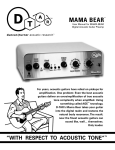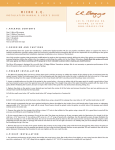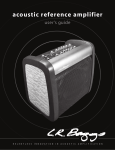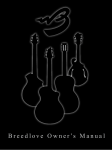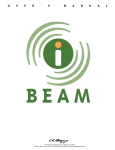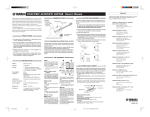Download L.R. Baggs Para D.I.: User`s Guide
Transcript
L . R P A R A . B A A C O U S T I C USER'S G G S P R E A M P S D . I . GUIDE 4 8 3 N . F R O N T A G E N I P O M O , C A R D . 9 3 4 4 4 W W W . L R B A G G S . C O M 1.CONTROLS A. Low EQ band control (85Hz): Very low bass, almost felt as much as heard. B. Notch control and tune knob (98 to 247Hz): Designed primarily to help with feedback problems. For example, if a particular string is starting to feedback or produce a booming sound, you can use the notch to cut out the problem frequency. The tune knob is marked with four positions, each representing a note on the scale, to help find the problem frequency. Try boosting the notch control (turn completely clockwise) and sweeping the tune knob until the feedback is at it's worst. Then turn the notch control back towards "cut" (counter-clockwise). Cut only enough to kill the feedback. The notch control can also be used as an EQ knob. A slight cut between D and B (around 200Hz) can clarify a boomy or muddy tone, and slight boosts in this range will give a thin-sounding guitar more body and acoustic sound. (see also: Invert Switch) C. Midrange control (400Hz to 1.6kHz) and tune knob: Sweeps from the upper warmth frequencies to the nasal range of sound. Boost at 400 for more warmth, cut at .8k-1.6k for less nasal quality. Many acoustic guitars have an excess 1kHz when amplified. A 3 to 6 dB cut is often good here. D. Presence control (5kHz): Affects "sss" sounds, cymbal sizzle, brightness. Cut here to remove PA horn "glare" or boost to add life to a dull speaker. E. Treble control (10kHz): The very highest frequencies, "air" or "frosting". F: Battery status LED: Stays on when unit is on and then flashes when the battery is low. The LED will start flashing when the battery reaches 6 volts. When it reaches 5 volts, it will stop flashing. G. Volume control: Unlike gain, whose adjustment will affect the character and personality of the sound, the volume simply controls the amount of signal that gets out of the box. The Para Acoustic D.I. will likely be the quietest thing in your signal chain. So for the best system signal to noise ratio, we recommend that you run the volume as high as you can without causing the PA to distort. H. External battery access compartment: For quick and easy battery changes. I. Balanced XLR output: A standard, post EQ/effects, balanced low impedance output. Plug it into the board with a microphone cable or stage/studio snake. If your board provides 48V phantom power on the XLR cable, the Para Acoustic D.I. will run on it instead of the battery. It's a good idea to keep a battery in the unit as a backup even when using phantom power. If phantom power drops, the preamp will automatically switch to the battery and run without interruption. J. Phantom power LED: Alerts you to the presence of 48V phantom power with a green light. K. 1/4" output: This is a regular unbalanced output for a standard mono cable. The output signal is the same as on the XLR, allowing you to use the 1/4" out and the XLR simultaneously for some creative signal routing. L. Invert switch: Changes the polarity of the signal. When the button is up, the output will be in phase with the input signal. Phase affects the way that the guitar top is pressurized by the loud speakers. When the two are out of phase with each other, low end feedback will be minimized. If inverting phase alone does not kill the feedback, use the notch filter. Phase will also affect the way the guitar signal mixes live and on tape (especially when overdubbing) with other instruments. M. Effects loop: This jack provides a send-return on a stereo jack for outboard effects that allow you to blend reverb, chorus or other effects in with a dry signal. Use an insert cable (stereo plug with a Y cable to two mono plugs) to connect the effect. The tip is the "send" and goes to the input of your effect. The ring is the "return" and comes from the output of your effect, and the sleeve is the ground. You may adjust the amount of effect in the signal by using the controls of the outboard effect. The send (tip) of this connector comes directly from the pure class A discrete input stage of the Para D.I., before the EQ, volume control, invert switch and output driver. Therefore it can be used as an immaculate, unbalanced direct output. It will not be affected by any of the panel controls (with the exception of the gain control). Use a regular mono cable. The effects loop interrupts the signal path. Therefore, it may also be used as an insert point for a compressor, volume pedal, or tuner if the tuner has a bypass switch. N. Gain control: See section 2: Setting the Gain. O. Instrument input: When you plug in, the preamp turns on. Note: If you plug or unplug your guitar with the power amp on, you will hear a loud "pop" from the speakers. Our proprietary "Soft Start" mute circuit reduces this, but it is still wise to turn down the power amp when plugging and unplugging. 2.SETTING THE GAIN Setting the gain: For optimum performance it is important to set the gain correctly to accommodate the output of your pickup, mic or other device. Gain is not volume. Gain is the amount of amplification that is applied to an input signal to boost it to a useful level. To accommodate a wide range of pickups, active devices and such, the Para D.I. has adjustable gain. For instance, if you are using a low-output passive pickup such as the Ribbon Transducer, and you fail to turn the gain all the way up, you will need to turn the PA up so loud to hear the pickup that there will be a significant amount of hiss. Conversely, if you plug a high-output active pickup into the Para D.I. and do not turn down the gain, you will hear a great deal of distortion. The key is to adjust the gain to find a window between hiss and distortion. The Para D.I. is so quiet that this window is pretty wide, but there is a smaller "sweet spot" within that window. With your pickup or mic plugged into the Para D.I., and with the Para D.I. plugged into your PA or amp, play your instrument very hard. Turn the gain trim up (clockwise) slowly while playing until you begin to hear some distortion, then back the gain off (counter-clockwise) until the distortion just disappears. This setting will provide both the richest and cleanest sound. Once you have determined your preferred setting, we recommend that you leave the gain control alone. Do not use the gain control as a volume control. Using it in this manner will vary the character of your sound as you adjust it up and down. Gain control settings: This chart shows the approximate recommended gain control setting when using L.R. Baggs pickups and systems. However, only experimentation with this setting can guarantee ideal results. Pickup Cord Length * Ribbon Transducer 12' LB6 Series 12' Hex Pickups 12' X-Bridge (passive) Setting 15' Y cable X-Bridge (Ctrl-X) Any Ribbon Transducer System Any Dual Source System Any Double Barrel Any * A standard guitar cable will attenuate our passive pickups by approximately 1dB per foot. The 12' cord used for this test already attenuates the signal by 12dB, compared to an onboard preamp. If you use a shorter or longer cord, adjust the gain accordingly. Our active pickups will drive any length of cord with no attenuation.



